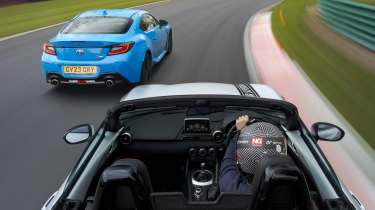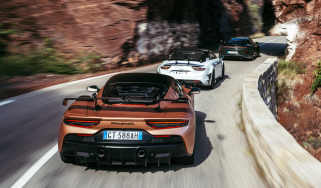‘Why Toyota and Mazda collaborating on next-gen sports cars makes me nervous’
If the next-generation Japanese sports cars are to be twinned, is there a risk their unique characters will be diluted?

It makes sense, doesn’t it? Toyota and Mazda, two companies with close business ties that are both famed for their lightweight, rear-wheel-drive, manual sports cars, are set to collaborate. That’s the story according to reports from Japanese magazine Best Car.
Though the two brands have yet to confirm or deny the tie-up, the next Toyota GR86 and the next Mazda MX-5 will reportedly be all but siblings (goodbye Subaru BRZ), built on the same platform and in the same factory. It might sound ungrateful, but I’m nervous of this amalgamation.
Both model lines were up to this point facing an uncertain future. While the MX-5 had been given a stay of execution for the next couple of years, it is now over ten years old. Likewise the GR86, which in spite of only launching in 2022, is a development of the GT86’s platform that was first introduced in 2012. That explains its market withdrawal due to that platform no longer being compliant with new European crash safety standards.

Now Mazda engineers are said to be working under Toyota’s roof, with Toyota’s money, on significantly updating the current ND MX-5 platform, to create both the next-generation of Mazda’s roadster, and a Toyota car by which the GR86 will be survived.
That doesn’t necessarily mean they’ll share engines. Best Car’s reporting has it that the Toyota variant will use its own hybridised 2-litre four-cylinder. Indeed we know Gazoo Racing is working on an all-new combustion engine family, the G16E, which has been testing in a wild mid-engined Yaris mule. Meanwhile the Mazda is supposed to use an updated hybridised version of its 2-litre engine. Two distinct engines for a family of cars built under one roof (Mazda’s Hiroshima facility, according to reports) does sound odd, though.
Regardless of the details, or indeed whether these reports turn out to be true, we have some reservations about the idea of these two, distinct, brilliant-in-their-own-way sports cars sharing DNA in the future. Toyota was once seriously considering the introduction of a model below the GR86 to rival the MX-5, previewed as far back as 2015 by the S-FR concept. That’s how different the GT86/GR86 and the MX-5 were previously seen to be.
Is there a risk that what makes each model line uniquely brilliant could be diluted if they’re forced to share DNA? Yes both are lightweight, rear-wheel-drive sports cars with manual transmissions and four-cylinder engines. But the way the Mazda carries itself is unique – with a free flowing gait it shares with its ancestors, particularly the original of 1990. It’s a car you celebrate for its simplicity, that you almost knead into its vast reserves of body roll. Every brisk drive in an MX-5 is a re-education experience on yaw and balance in a car, as they once were.

The GR86 on the other hand, while still possessed of an awesome sense of humour, is an altogether more serious car. It’s stiffer, it’s broader of footprint on the road (a 2+2 after all) and it’s slightly heavier. It’s more tied down in terms of its body control, more sophisticated and capable in feel and more dextrous on and over the limit. Both are wonderful, both punched well above their weight, dicing with supercars in past evo Car of the Year contests. But they are distinct characters.
Toyota has burned itself before in collaborations that, while commonsense in concept, produced cars that lacked authenticity. Look at the competent but largely derided BMW-twinned Supra, compared to the all-Toyota, almost universally loved GR Yaris. On the flip side, the MX-5 is almost a roadster of the past preserved in the present – a character unchanged for 30 years, first inspired by a Lotus of the 1960s. That's not to mention a fanbase that’s incredibly nervous of change – a fanbase that might even prefer to see the MX-5 die before they see its unique character diluted…
Our advice, if this collaboration is really happening? Do the opposite of what’s being reported. Develop an engine and manual transmission together (better yet, keep the current MX-5’s fabulous manual), but keep the platforms separate enough that they can sustain two cars with distinct dynamic characters. No, it isn’t lost on me that we should be grateful these cars might have a future at all but shoot me, I want to have my cake and eat it too.




